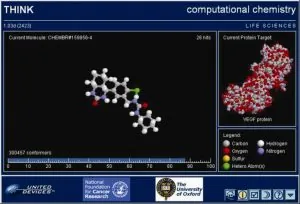NFCR-Funded Project in Early 2000s Leads to Progress Today in Computational Drug Design
InhibOx Receives Investment to Fight Drug-Resistant Bacteria

The National Foundation for Cancer Research is delighted that computer-aided drug-resistance research is now getting increased funding across the pond! NFCR lauds the selection of InhibOx Ltd. as the company to receive a nearly £1 million grant from Innovate UK to continue research into novel anti-resistance, cancer-fighting antibiotics.
“What started out as the ScreenSaver Life Saver project by the NFCR Centre for Computational Drug Design in 2000 has become a global research phenomenon that is supported by hundreds of millions of dollars today,” said NFCR President Sujuan Ba, Ph.D. “It takes a long, long time for that first seed investment in research to reach the translational and clinical stages, but when you prioritize innovative projects, it does pay off. It is incredibly rewarding to follow the successes of InhibOx and see how our global work almost two decades ago set the stage for current advances in the critical medical research community.
InhibOx Ltd. was founded in 2001 and built off the pioneering Screensaver LifeSaver project, in which NFCR teamed with technology companies Intel, United Devices and the University of Oxford to turn personal computers into a virtual supercomputer to be used in the discovery of new drugs to combat cancer. InhibOx was specifically created as a spin-off company by Professor Graham Richards, Chairman of the University of Oxford’s Chemistry Department, Director of the NFCR Centre for Computational Drug Design and a leader of the Screensaver LifeSaver Project.
Speaking about the Screensaver LifeSaver project in 2001, Professor Richards said, “This is the largest computational chemistry project ever undertaken.”
Question: What was the NFCR Centre for Computational Drug Design?
Answer: NFCR, a U.S.-based charity, provided funding for a ground-breaking global effort to discover anti-cancer drugs.
NFCR provided over $2.25 million in funding from 1983 to 2010 to Professor Graham Richards’ research on computational drug design, which later lead to the establishment of the NFCR Centre for Computational Drug Design at the University of Oxford. The centre was a virtual consortium that included researchers from several European countries and the ScreenSaver LifeSaver Project stemmed from the work in this centre.
Flashback: The Screensaver LifeSaver Project

In 2001, Franklin C. Salisbury Jr., CEO of NFCR said, “This technology gives individuals a chance to use their idle computer time to assist in the discovery of new drugs to combat cancer.”
And after years of collecting data, the Screensaver LifeSaver Project used the idle time of over 3.5 million personal computers linked through the internet to computationally screen a large database of molecular structures. From 2000-2007, more than 3.5 billion drug-like molecules were screened against 12 cancer targets, which yielded tens of thousands of lead compounds that were analyzed by science project leaders and used to identify new anti-drug candidates.
Where Are We Now?












